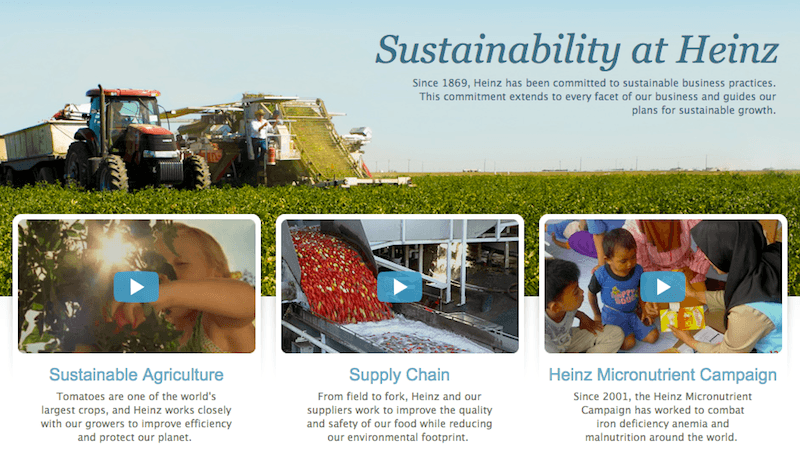
By Alexis Caffrey
Nowadays, incorporating sustainability into your communications plan is a fundamental part of a company’s success. In fact, consumers around the world are more likely to be loyal to a company that incorporates sustainable practices into their business.
Highlighting your company’s sustainability effort, and being transparent to the public, can be profitable for your company. By promoting your company’s green technology, or social and environmental initiatives, your company can benefit by receiving positive PR exposure and connecting with new target markets.
Let’s take a look at how some industries have seamlessly worked sustainability into their communication efforts in order to increase profitability.
A focus on metrics and transparency
Unilever and Heinz are two large brands that have made sustainable living a large piece of their marketing plans and business practices. You’ll even notice on each of their websites that “sustainable living” is a main menu item.Unilever heavily relies on metrics and reporting to communicate its sustainability efforts to the public. In fact, the packaged goods company's website is filled with updates on its performance in real time. Interactive charts display economic, social and environmental performance data. Stakeholders are given the opportunity to view Unilever’s environmental impacts and data and share information via social media. In fact, stakeholders, including the Unilever Sustainable Living Plan Steering Team, external advisors and consumers, are able to offer feedback about Unilever’s efforts.
Heinz is another company that has emphasizes sustainability on its website. Like Unilever, it focuses on transparency and reporting to convey its sustainability efforts to stakeholders and consumers. According to its website, Heinz's efforts include cutting a ton of energy per ton of product in its manufacturing process, as well as reducing waste to landfill. Its program is so impressive that Heinz has won awards and recognition for being a sustainability leader.
By being completely transparent, and updating reports on an ongoing basis, these companies have been able to reach a broader audience, while capturing the trust of their current stakeholders and consumers. Their sophisticated and interactive websites will set the tone for companies in the future when looking to integrate their sustainable efforts and public facing communications.
Best practice example: Finding a new use for an old product
The gutter protection industry usually advertises that they protect a home from serious and costly damage that is associated with clogged gutters. While this is true, most people are unaware that gutter protection systems help with rainwater reclamation.
By using a micromesh gutter protection system, like Leaf Filter, homeowners can flow fresh rainwater through their rain gutters and downspouts, and into rain barrels. The rainwater can be used for lawn care, gardening, filling swimming pools and, with treatment, brought into the home to fulfill water needs. In return, rainwater harvesting puts less strain on their municipal water supply, and makes it an appealing solution to lessen a homeowner’s water and sewage bills.
Most recently, the gutter protection industry has been able to highlight and promote this benefit across social media and on their websites. By adding green and sustainable communications to their marketing plan, and promoting it on social media and their website, the gutter protection industry has been able to pique a new audience’s attention.
Do your research: Use the right buzzwords
When it comes to communicating your sustainability efforts, incorporating green buzzwords can have real implications on your marketing communication efforts.
The Shelton Group, a leading marketing communications firm focused on energy and environment, tested 11 popular green buzzwords to find out how consumers felt when they saw a certain buzzword associated with sustainability. Interestingly, 67 percent of consumers responded positively to the word “green,” while 63 percent of them noted it was important. “Eco-friendly” and “sustainable” are also buzzwords that resonate with consumers.
The Shelton Group’s research is extremely interesting and helpful when determining what type of green jargon is appropriate to use in a marketing communications plan. We suggest downloading the organization's study to learn more about using appropriate green terms, and conducting your own research with a focus group that is specific to your industry.
Key takeaways
Over time, there will be a greater emphasis and media attention on sustainable corporate practices. We have already seen many successful companies successfully integrate their sustainable efforts into a communication plan through traditional and non-traditional methods.
Undoubtedly, companies that are integrating sustainable efforts – whether it is through lowering emissions, improved energy efficiency or promoting equitable working environments – have a distinct advantage in their industry. Not only will these efforts help companies be more profitable, but their sustainability efforts will also reduce their environment footprint, while increasing their positive social impact.
Image courtesy of Heinz (screenshot)
Alexis Caffrey is a freelance writer who enjoys writing about all things related to home improvement and sustainability. She welcomes your feedback via email - alexiscaffreywriter@gmail.com.
TriplePundit has published articles from over 1000 contributors. If you'd like to be a guest author, please get in touch!














